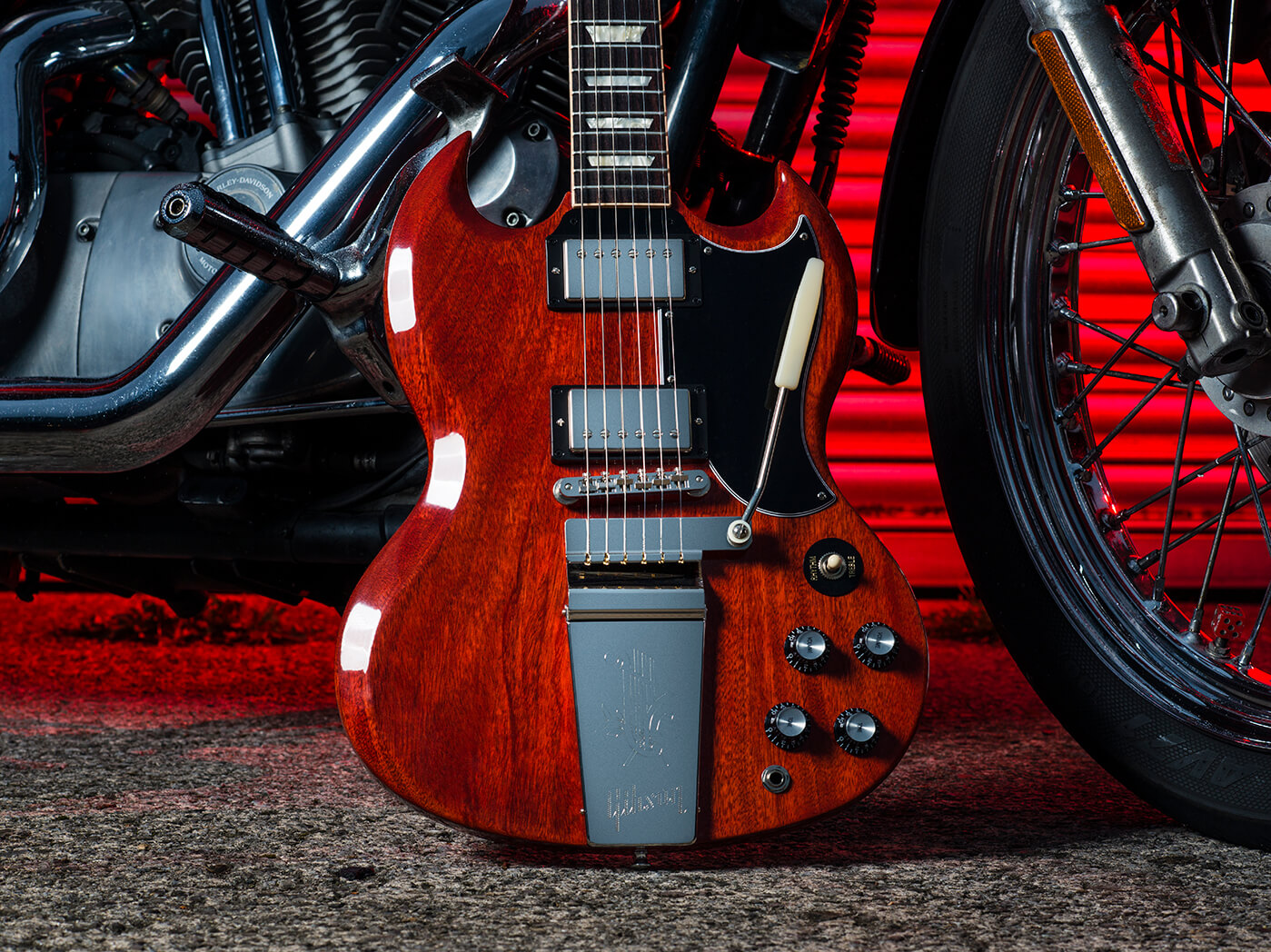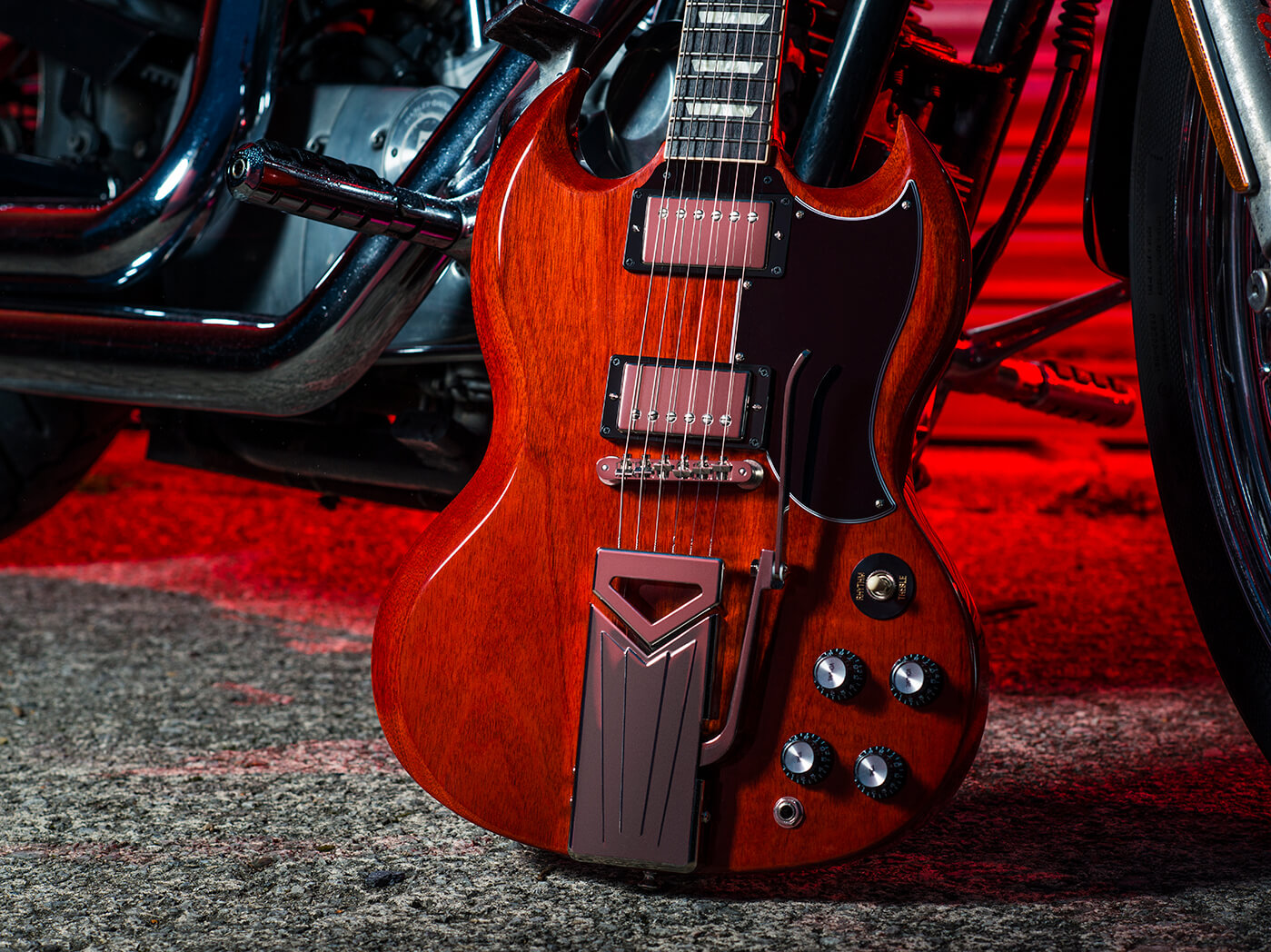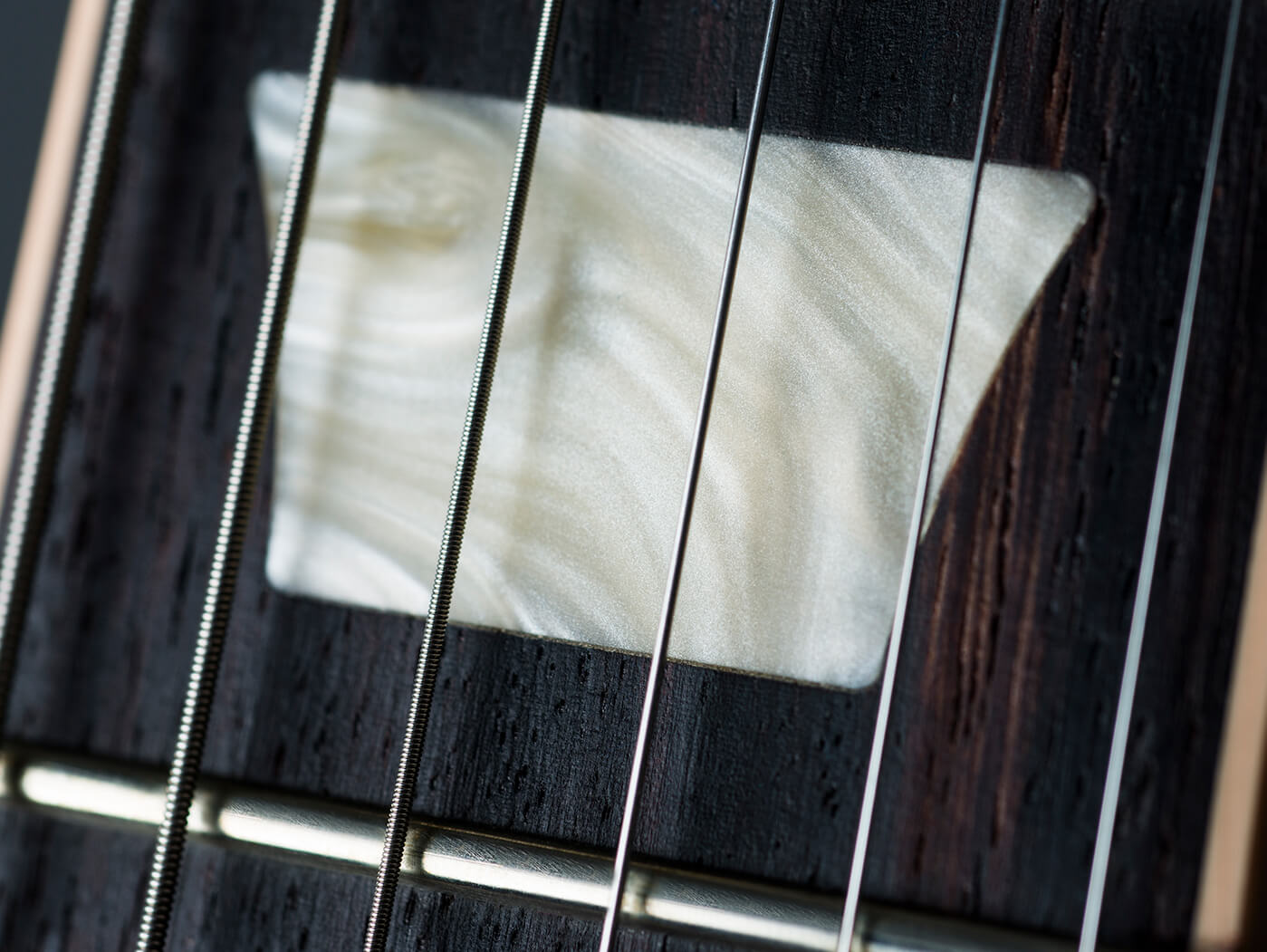Gibson Sg Standard 61 2019 Electric Guitar Review
Knowing what your client wants is one of the keys to whatever successful business, but for the last couple of decades, it often felt like Gibson wasn't listening. Relentless model yr updates, gimmicky tech and undesirable changes to the classic recipe – not to mention a general perception amidst the guitar-buying public of falling QC standards – made for a baffling array of models and a perception that if yous wanted Gibson to brand 'em like it used to, the premium prices of the Custom Shop were the only selection.
A change of management so often brings a change of mindset and hither, it's a change for the better. With Gibson's electric-guitar production line-up now streamlined into the Original, Mod and Custom Shop Collections, vintage features no longer come up simply at near-vintage prices. Here, nosotros're looking at a trio of reasonably-priced SGs from the Original Drove featuring hand-wired controls, vintage-correct cervix profiles and lightweight Fijian mahogany. Time to dive in.
Student tone
As yous might await from its stripped-back specifications, the 'educatee' model SG Junior is the lightest of our iii review guitars by some margin. Even the headstock is a fraction smaller – it's slightly narrower across the height. The neck profile is a footling rounder than the other 2 instruments, with a slightly fuller 'C', rather than a flat and broad 'D'.
Handling the neck'due south soft, vintage-style shoulders, it's pleasing to note that Gibson can even so cut information technology with the all-time – both past and present – when it comes to neck profiles. It feels very vintage, in the best sense and that impression is reinforced when the frets are viewed from the sides.

They have that broad-but-depression expect of old wire, just they're plenty high plenty for bending strings and yous don't get that 'speed bump' feel as your fingers slide along the fretboard. Although they're seated well enough and nicely crowned, we exercise think a few extra minutes with a file would raise comfort levels fifty-fifty further. Both the Standard models have fret nibs, then it'southward only an issue for the Junior.
The published specs for all three guitars include Orangish Drop tone capacitors and Gibson has worked on the pot tapers for a more vintage-style response. The wiring certainly appears very vintage-correct, with black trunking and yellow plastic insulation on the footing wires. On our review model, nevertheless, the Junior's tone capacitor is tiny and light bluish – we'd approximate it'south probably ceramic.

Given that Gibson'south attempt at intonation compensation during the 1960s was optimised for wound-Thou string sets, the uncompensated bridge nosotros have here is actually preferable and the intonation sounds just fine.
Double whammy
When is an SG not an SG? Information technology'south understandable that Gibson would desire to avert confusion in its 2019 product range, but dorsum in 1961, when this version of the SG was first introduced, it was actually the new Les Paul Standard.
This was the sleek, streamlined and modernistic guitar that was designed to supplant those 'shrunk-in-the-wash' jazzboxes known as Goldtops and 'Bursts (after all, they were non doing great business for Gibson at the time). The very earliest examples of the new model even had Les Paul's name on the truss-rod cover, but here it's left manifestly.

The first of our twin-humbucker SG Standard '61 reissues features the Maestro Vibrola with a Lyre engraved on the tailpiece cover. In addition, there'south a 'Slim Taper' mahogany neck with a bound rosewood fingerboard and a 22nd-fret cervix joint. The hardware is nickel-plated and the Burstbucker 61R and 61T humbuckers are designed for "a classic voice with added power and top end". Bated from its infamous lateral-move vibrato arrangement, all the specifications for the Sideways Vibrola model are identical to the Maestro-equipped instrument.
Equally luck would have information technology, nosotros have a vintage 1961 Maestro Vibrola-equipped SG on hand to compare with the reissue models. The weights are fairly similar, with the sometime and new guitars measuring 3.25kg/7.16lb and 3.33kg/7.34lb respectively. There are, however, a few aesthetic differences. The headstock on the vintage model is wider, whereas the reissue headstock has less of that 'paddle' expect. The pickguard shapes are different, too, with the longer vintage guard extending closer towards the pickup-selector switch and befitting more closely to the body outline.

On all three of our review models, the tuners are Gibson'due south electric current standard fittings, which are more vintage-inspired than vintage-authentic. It's certainly not worth losing slumber over, but a more pedantic reissue might have tuners with single-line casings and double-ring buttons. The machineheads on these guitars are the other way around, with double-line casings and single-line buttons, apart from the Inferior, which has the simpler buttons reserved for 'educatee' models.
Rather than a printing-fit ring, the tuner bushings take a washer and bolt configuration, which no doubt adds a little mass to the headstocks, but non enough to cause problems with neck dive.
In apply
In the world of electrical-guitar construction, combining lightweight mahogany with an aluminium wrapover tailpiece is as close to a dead cert every bit information technology gets. Even so, this Junior'south unplugged tone is cypher short of astonishing – strum whatever chord and vibrations can be felt through the body and neck.

The tonality is bright and chiming, merely things get woody through the mids and in that location'due south plenty of bass depth. The sustain greatly impresses and, with its perfect playability and sublime neck profile, the experience is very much akin to playing a flawless vintage model.
At that place are no existent surprises when we plug in, and bluntly, we wouldn't want whatsoever. The P-90 is hot without being over the top, there's a stiff midrange button, growling lows and enough of bite in the upper mids and treble for articulation.
We compare information technology with the bridge P-90 in a 1962 ES-330 and it has to be said that the SG Junior acquits itself very well. The modern P-xc falls slightly short in terms of clarity and depth of tone, just information technology's a high bar indeed and the mod unit of measurement is still a very decent pickup. It likewise cleans upwardly without losing clarity when the book control is backed off and there's more than enough tone control range to dial in a bright amp tone, set the tone control about halfway and apply it as a simulated pickup switch.

There's quite a difference between the unplugged tones of the two Vibrola-equipped Standards. With the Sideways vibrato onboard, the tone is pleasant enough, simply the airy treble sheen of the Maestro-equipped model is pretty much absent. The Sideways Vibrola model has a warmer and more compressed response and it'southward very much in line with what we have come to associate with many SGs, both new and old.
Unfortunately, our vintage 1961 SG is loaded with non-original pickups and unplugged comparisons are complicated by the fact that it has nylon rather than metal saddles. With all Melody-o-matic equipped Gibsons, the saddle cloth has a significant sonic influence.
The Maestro-equipped reissue actually sounds brighter and has a more clearly divers set on at the front of the note. In contrast, the vintage model is fifty-fifty warmer and woodier, and there'south a affect less sustain. Based on previous parts-swapping experiments, nosotros're certain that these characteristics would transfer from one guitar to the other if we swapped over the bridges.

Plugged in, the fact that the mod Maestro and Sideways Vibrola models sound so different through an amp can be attributed to the quality of Gibson's manufactory pickups. A pleasing amount of microphony, combined with vintage output, allows each guitar'southward acoustic qualities to come through.
Both audio like unusually practiced SGs, with that throaty growl on the depression strings for raunchy riffing and an articulate bite that makes single notes cut through without sounding shrill. There's enough of tonal dissimilarity between the bridge and neck and in authentic vintage-way the bridge can sound a touch likewise bright at times. Rather than a drawback, we consider this welcome headroom and, like Joe Bonamassa, we're inclined to play with the bridge tone control slightly dialled back to emphasise the midrange bark.
The book controls do have a genuinely old-school response and in the middle position, it'south so easy to notch dorsum the neck volume command to produce a pleasing quackiness. But as much as we savor the Sideways Vibrola model's fluty warmth and smooth characteristics, the natural airiness of the Maestro model is so much more engaging and opens the guitar upward for shimmering cleans every bit well as darker dirt.

In combination with the fantabulous control response, the Maestro model can produce a stunning range of sounds. In fact, it'south one of the virtually enjoyable and engaging humbucker-equipped SGs we have ever played. And yes, you lot can include all original vintage examples in that list.
There are plenty of encouraging signs that Gibson is moving in the right direction. Although there's goose egg new about any of these SGs, at the same time, at that place's a freshness and finesse that makes them hard to fault. The slightly faded scarlet stop is consistent across all three guitars and we honey it. It'southward non besides cherry-red, nor is it too done out – it'south but about perfect.
We would also note that the quality of the cease is a lot meliorate than we've seen on some Gibsons in recent years, because it feels sparse, perfectly apartment and there isn't even a hint of 'orange skin'.

Our 1 gripe – and information technology doesn't apply to the Junior – is Gibson's persistent apply of slightly peach-coloured bounden. Nosotros tin can only assume that years agone, a edible bean-counter secured a killer deal on the condition that Gibson purchased colossal quantities of the stuff. Nosotros can only hope that supplies are near used upwards or that somebody in authority will finally call time and enforce Gibson'south return to off-white binding.
Having two SGs spec'd identically besides their vibrato units gives united states of america a rare opportunity to compare the Maestro with the Sideways Vibrola. We have a articulate preference and would cull the Maestro every time. Although overshadowed by Bigsbys and the various Fender systems, the Maestro is actually a very usable and impressively stable whammy bar.

In contrast, the Sideways Vibrola adds considerable mass for petty or no applied gain. It looks absurd, but it's awkward to use and throws the guitar out of tune. You tin elect to swing the arm out of the way, only be careful about injuring your picking manus on the sharp corners if you want to switch pickups. The irony is that hither, Gibson has washed a stellar task of recreating a piece of equipment that was never very good in the outset identify!
Although all vibratos are designed to accomplish the same issue, it'southward interesting how the feel of each leads you to approach them in unlike ways. The Stratocaster's is perhaps the almost playable and expressive for soloing, while Bigsbys are often more atmospheric and musical when you lot're adding vibrato to chords and slurring notes.

The Maestro combines elements of both, with the immediacy of the Strat vibrato, just the restricted pitch variation of a Bigsby. Consequently, it excels for fast and fluttering vibrato effects and and then long equally you tin go on your head, a Maestro will keep you lot in tune. Of course, the Junior is trem gratuitous, but you can become almost as much pitch-shift but by shaking the neck and information technology stays in tune remarkably well.
For entirely unlike reasons, the SG Inferior and the Maestro Vibrola Standard are our clear winners hither. There'due south something thrillingly stripped back about the Junior and its neck is the pick of the bunch. But the tonal range, coupled with the expressiveness and tuning stability of the vibrato, keeps drawing usa back to the Maestro-equipped Standard '61.
Key Features
SG Junior 9/10
- Toll £1,149 (including hard-beat case)
- DESCRIPTION Solidbody electrical guitar. Fabricated in the USA
- BUILD Fijian mahogany body, mahogany set neck with medium C contour, 12" radius rosewood fingerboard with pearl dot inlays and 22 frets
- HARDWARE Wrapover bridge, vintage-style white button tuners
- ELECTRONICS 1x P-90 Dog Ear pickup, book, tone
- SCALE LENGTH 629mm/24.75″
- Neck WIDTH 43mm at nut, 53.3mm at twelfth fret
- NECK DEPTH 20mm at start fret, 22.5mm at 12th fret
- STRING SPACING 36.4mm at nut, 53mm at bridge
- WEIGHT ii.6kg/5.7lb
- LEFT HANDERS Aye
- FINISH Vintage Carmine
- VERDICT Instant tone, fabled sustain and playability and nothing to fuss virtually brand this a well-nigh perfect plug-and-play guitar
SG Standard '61 Maestro Vibrola 9/ten
- Cost £1,649 (including difficult-shell instance)
- DESCRIPTION Solidbody electric guitar. Made in the USA
- BUILD Fijian mahogany body, mahogany set neck with 'Slim Taper' profile, 12" radius leap rosewood fingerboard with pearl inlays and 22 frets
- HARDWARE Tune-o-matic span, Maestro Vibrola vibrato tailpiece, vintage-style tuners
- ELECTRONICS Burstbucker 61R (cervix) and 61T (bridge) humbucking pickups, individual volume and tone controls, 3-way toggle switch
- Scale LENGTH 629mm/24.75″
- NECK WIDTH 43.4mm at nut, 53.6mm at twelfth fret
- NECK DEPTH 20mm at showtime fret, 22.5mm at 12th fret
- Cord SPACING 35.5mm at nut, 52mm at bridge
- WEIGHT 3.6kg/7.9lb
- LEFT HANDERS No
- FINISHES Vintage Cherry
- VERDICT A stable and expressive vibrato and articulate and versatile vintage-toned pickups make this an inspiring SG
SG Standard '61 Sideways Vibrola 8/ten
- PRICE £1,649 (including hard-crush case)
- DESCRIPTION Solidbody electric guitar. Fabricated in the Usa
- BUILD Fijian mahogany body, mahogany fix neck with 'Slim Taper' profile, 12-inch radius leap rosewood fingerboard with pearl inlays and 22 frets
- HARDWARE Tune-o-matic bridge, Sideways Vibrola tailpiece, vintage-style tuners
- ELECTRONICS Burstbucker 61R (neck) and 61T (bridge) humbucking pickups, private volume and tone controls, 3-fashion toggle switch
- SCALE LENGTH 629mm/24.75″
- NECK WIDTH 43.4mm at nut, 53.5mmat 12th fret
- NECK DEPTH 20mm at first fret, 22.5mm at 12th fret
- STRING SPACING 35.5mm at nut, 52mm at bridge
- WEIGHT 3.3kg/7.3lb
- LEFT HANDERS No
- FINISHES Vintage Cherry
- CONTACT Gibson gibson.com
- VERDICT A darker and smoother tone that'south very much classic SG, but the Sideways Vibrola should be regarded as largely decorative
More information at gibson.com.
Source: https://guitar.com/review/electric-guitar/gibson-sg-junior-sg-standard-61-maestro-vibrola-sg-standard-61-sideways-vibrola/
0 Response to "Gibson Sg Standard 61 2019 Electric Guitar Review"
Postar um comentário